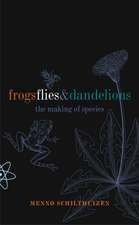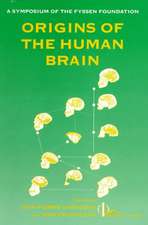Competition: Population and Community Biology Series, cartea 26
Autor P.A. Keddyen Limba Engleză Hardback – 28 feb 2001
Greatly expanded from the first prize-winning edition, there are entirely new chapters, including one on resources and another on competition gradients in nature. The author freely ranges across all major taxonomic groups in search of evidence. The question of whether competition occurs is no longer useful, the author maintains; rather the challenge is to determine when and where each kind of competition is important in natural systems. For this reason, variants of competition such as intensity, asymmetry and hierarchies are singled out for particular attention. The book concludes with the difficulties of finding general principles in complex ecological communities, and illustrates the limitations on knowledge that arise out of the biased conduct of scientists themselves.
Competition can be found elsewhere in living systems other than ecological communities, at sub-microscopic scales in the interactions of enzymes and neural pathways, and over large geographic areas in the spread of human populations and contrasting ideas about the world. Human societies are therefore also examined for evidence of the kinds of competition found among other living organisms. Using an array of historical examples, including Biblical conflicts, the use of noblemen's sons in the Crusades, the Viking raids in Europe, strategic bombing campaigns in the Second World War, and ethnic battles of the Balkans, the book illustrates how most of the aspects of competition illustrated with plants and animals can be extended to the interactions of human beings and their societies.
| Toate formatele și edițiile | Preț | Express |
|---|---|---|
| Paperback (2) | 383.50 lei 6-8 săpt. | |
| SPRINGER NETHERLANDS – 31 mai 1989 | 383.50 lei 6-8 săpt. | |
| SPRINGER NETHERLANDS – 30 noi 2001 | 1393.27 lei 6-8 săpt. | |
| Hardback (1) | 1236.19 lei 6-8 săpt. | |
| SPRINGER NETHERLANDS – 28 feb 2001 | 1236.19 lei 6-8 săpt. |
Din seria Population and Community Biology Series
- 15%
 Preț: 646.11 lei
Preț: 646.11 lei - 18%
 Preț: 1224.54 lei
Preț: 1224.54 lei -
 Preț: 404.51 lei
Preț: 404.51 lei -
 Preț: 381.98 lei
Preț: 381.98 lei -
 Preț: 396.62 lei
Preț: 396.62 lei -
 Preț: 393.13 lei
Preț: 393.13 lei -
 Preț: 382.95 lei
Preț: 382.95 lei - 5%
 Preț: 373.47 lei
Preț: 373.47 lei - 18%
 Preț: 1221.38 lei
Preț: 1221.38 lei - 18%
 Preț: 1224.36 lei
Preț: 1224.36 lei -
 Preț: 383.71 lei
Preț: 383.71 lei - 24%
 Preț: 1045.08 lei
Preț: 1045.08 lei - 24%
 Preț: 1033.06 lei
Preț: 1033.06 lei - 18%
 Preț: 1228.62 lei
Preț: 1228.62 lei - 18%
 Preț: 1546.05 lei
Preț: 1546.05 lei - 18%
 Preț: 959.98 lei
Preț: 959.98 lei - 18%
 Preț: 953.65 lei
Preț: 953.65 lei - 15%
 Preț: 635.80 lei
Preț: 635.80 lei - 18%
 Preț: 950.52 lei
Preț: 950.52 lei - 18%
 Preț: 834.17 lei
Preț: 834.17 lei - 15%
 Preț: 644.95 lei
Preț: 644.95 lei -
 Preț: 405.66 lei
Preț: 405.66 lei -
 Preț: 391.99 lei
Preț: 391.99 lei - 15%
 Preț: 637.78 lei
Preț: 637.78 lei -
 Preț: 383.93 lei
Preț: 383.93 lei -
 Preț: 397.38 lei
Preț: 397.38 lei - 15%
 Preț: 640.06 lei
Preț: 640.06 lei
Preț: 1236.19 lei
Preț vechi: 1507.55 lei
-18% Nou
Puncte Express: 1854
Preț estimativ în valută:
236.54€ • 246.97$ • 195.77£
236.54€ • 246.97$ • 195.77£
Carte tipărită la comandă
Livrare economică 04-18 aprilie
Preluare comenzi: 021 569.72.76
Specificații
ISBN-13: 9780792360643
ISBN-10: 0792360648
Pagini: 552
Ilustrații: XVII, 552 p. 45 illus.
Dimensiuni: 155 x 235 x 32 mm
Greutate: 0.98 kg
Ediția:2nd ed. 2001
Editura: SPRINGER NETHERLANDS
Colecția Springer
Seria Population and Community Biology Series
Locul publicării:Dordrecht, Netherlands
ISBN-10: 0792360648
Pagini: 552
Ilustrații: XVII, 552 p. 45 illus.
Dimensiuni: 155 x 235 x 32 mm
Greutate: 0.98 kg
Ediția:2nd ed. 2001
Editura: SPRINGER NETHERLANDS
Colecția Springer
Seria Population and Community Biology Series
Locul publicării:Dordrecht, Netherlands
Public țintă
ResearchCuprins
1 Studying Competition.- 1.1 The Importance of Competition.- 1.2 Stress, Strain and the Costs of Competition.- 1.3 Other Views on the Definition of Competition.- 1.4 Kinds of Competition.- 1.5 Historical Foundations: The First Competition Experiment.- 1.6 Competitive Dominance.- 1.7 Competition and the Organization of Living Systems.- 1.8 Competition and Human Societies.- 1.9 Conclusion.- 2 Resources.- 2.1 Kinds of Resources.- 2.2 Resources for Primary Producers.- 2.3 Resources for Consumers.- 2.4 Experimental Studies of Foraging for Resources in Patchy Environments.- 2.5 Effects of Chronic Scarcity of Resources.- 2.6 Resource Levels Change with Time.- 2.7 Humans and Resources.- 2.8 Conclusion.- 3 Competition in Action.- 3.1 Case Studies of Intraspecific Competition.- 3.2 Case Studies of Interspecific Competition.- 3.3 Literature Review of Case Studies.- 3.4 The Current Situation.- 4 Choosing the Tools.- 4.1 Descriptive, Comparative and Experimental Studies.- 4.2 Descriptive Studies.- 4.3 Comparative Studies.- 4.4 Experimental Studies.- 4.5 Choosing a Research Path.- 5 Competitive Hierarchies.- 5.1 Patterns in Community Matrices.- 5.2 Eight Examples of Communities with Competitive Hierarchies.- 5.3 On the Consistency of Hierarchies.- 5.4 Monocultures and Mechanisms.- 5.5 Intra-and Intergroup Competition Among Humans.- 5.6 Conclusion.- 6 Traits and Competitive Performance.- 6.1 Relative Abundance Patterns.- 6.2 Ants.- 6.3 Plants.- 6.4 Amphibians.- 6.5 Apes.- 6.6 The Problem of Co-existence and Competitive Similarity.- 6.7 Conclusion: A Place for Everything.- 7 Competition Gradients.- 7.1 The Search for Gradients of Competition Intensity.- 7.2 Experimental Gradients.- 7.3 The Universal Constant of Competition.- 7.4 On Discrepancies and Reconciliations.- 7.5 Competition and Succession.- 7.6 Conclusion.- 8 Extending the Generality of Field Experiments.- 8.1 Criticisms Regarding Lack of Generality.- 8.2 Demonstrating Generality of Pattern.- 8.3 Using Increased Numbers of Species.- 8.4 Providing a Comparative Context.- 8.5 Using General Experimental Factors.- 8.6 Arrangement Along Gradients.- 8.7 Practical Trade-offs.- 8.8 A Large Scale Competition Experiment.- 8.9 Conclusion.- 9 Modelling Competition.- 9.1 Kinds of Models.- 9.2 The Lokta-Volterra Models.- 9.3 The MacArthur Model for Resource Subdivision.- 9.4 Loop Analysis and Apparent Competition.- 9.5 Competition Along Gradients.- 9.6 A Resource Competition Model.- 9.7 A Biomechanical Model.- 9.8 A Spatial Model.- 9.9 A Model of Behaviour and Habitat Use.- 9.10 Competitive Neighbourhood Models.- 9.11 Competition in Forests: The JABOWA and FORET Models.- 9.12 The Lateral Pressure Model for Global Conflict.- 9.13 The Richardson Arms Race Model.- 9.14 Two Graphical Models for Resource Partitioning.- 9.15 Obstacles to Testing Models.- 9.16 Conclusion.- 10 Competition, Pragmatism and Comparison.- 10.1 A Pragmatic Approach to Competition.- 10.2 The Search for General Patterns in Astronomy.- 10.3 Comparisons Among Habitats.- 10.4 Constraints on Competition in Plant Communities.- 10.5 Constraints on Competition in Animal Communities.- 10.6 Comparisons Among Organisms.- 10.7 Making Theories Operational for Hypothesis Testing.- 10.8 Experimental Stress and Disturbance Gradients.- 10.9 Meta-analysis in Competition Studies.- 10.10 Three Kinds of Community Structure (Resource Partitioning Revisited).- 10.11 Competition, Resources and Tyranny.- 11 Goals and Obstacles in the Study of Competition.- 11.1 Setting Goals.- 11.2 Brains and Their Limitations.- 11.3 Choosing a Question.- 11.4 Choosing Appropriate Model Systems.- 11.5 Selecting a Conceptual Approach.- 11.6 Obstacles to Communication.- 11.7 Conclusion.- References.
Recenzii
"Competition (2nd Edition) by Keddy provides an overview of past and current work on competition, and suggests promising directions for future research. The book includes many elements that should help accelerate the rate at which knowledge is gained in the field. It encourages the consideration of taxonomic groups belonging to all kingdoms, not only the study of charismatic mammal and bird species. Accordingly, Keddy provides examples of competition in a wide array of species, including interesting examples suggesting that today's human societies have been largely shaped by competitive interactions. Competition (2nd Edition) is more than a literature review; the book also highlights exciting new research areas, and suggests how to empirically approach these deserving themes. It constitutes an important contribution to the field by providing the means to enhance the value of future competition studies. Ecologists should benefit from reading the book because it provides tools to maximize the rate of knowledge acquisition per unit of research effort." (Daniel Fortin, Department of Biological Sciences, University of Alberta, Edmonton, Canada Ecoscience, 10:3 (2003)
"This expanded and revised edition of Paul Keddy's well known book on competition includes many recent examples and new written chapters on competition gradients, competitive hierachies and resoureces with extended discussion of models and of evolutionary aspects of the subject. It contains examples to help explain the theories being discussed and there are numerous line drawings." (Review Editor Bulletin of the British Ecological Society, August 2003, 34:3)
"This expanded and revised edition of Paul Keddy's well known book on competition includes many recent examples and new written chapters on competition gradients, competitive hierachies and resoureces with extended discussion of models and of evolutionary aspects of the subject. It contains examples to help explain the theories being discussed and there are numerous line drawings." (Review Editor Bulletin of the British Ecological Society, August 2003, 34:3)

















